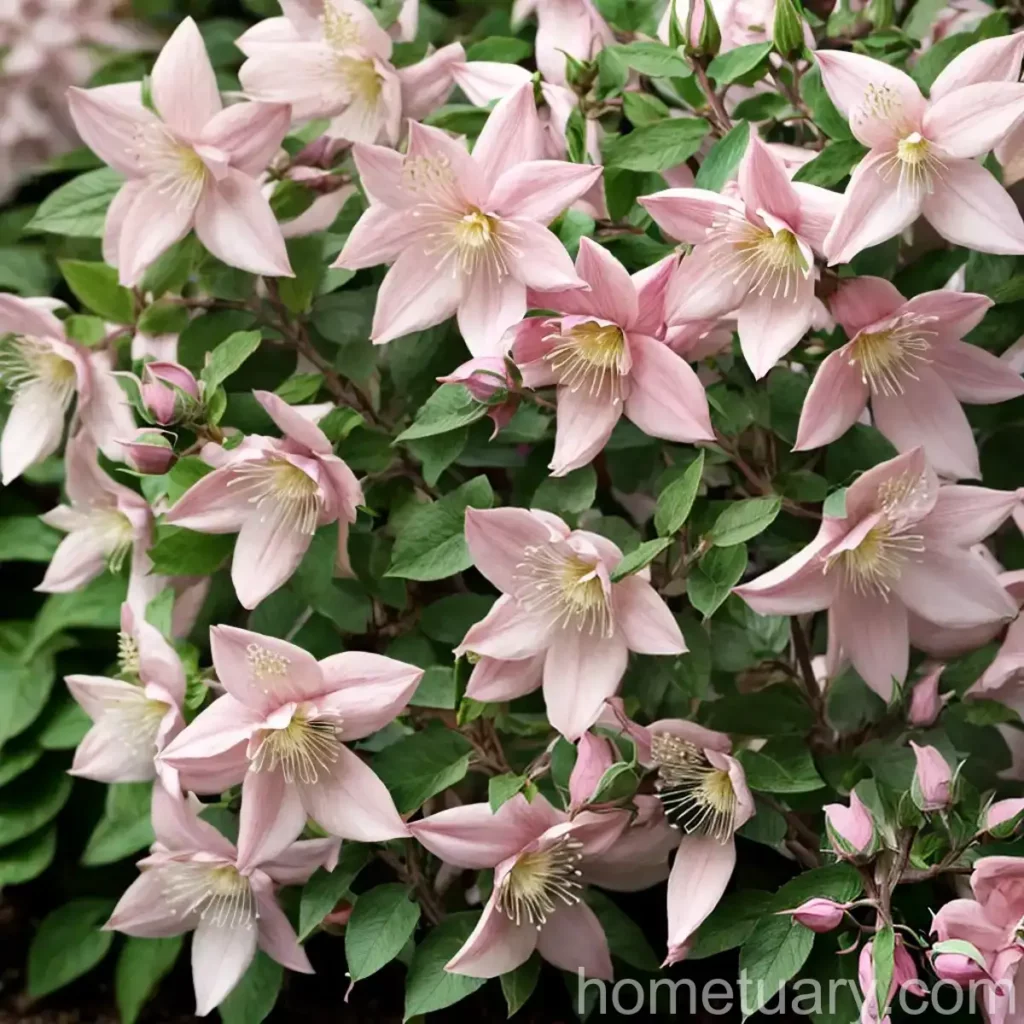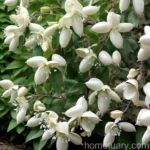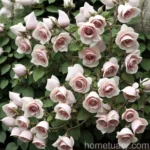The Beauty of Deutzia (Deutzia x hybrida ‘Perle Rose’)
Deutzia, specifically the Deutzia x hybrida ‘Perle Rose,’ is a stunning and versatile shrub that has become a favorite among gardeners for its beautiful blooms, low maintenance requirements, and ability to attract pollinators.
In this comprehensive guide, we will delve into the various aspects of the deutzia plant, including its culture, uses, water and sunlight requirements, fertilization needs, soil preferences, pruning techniques, propagation methods, common diseases and pests, as well as fun facts and botanist’s tips for successful growth. Let’s explore the enchanting world of deutzia and uncover all there is to know about this remarkable plant.
What is Deutzia (Deutzia x hybrida ‘Perle Rose’)?
The deutzia, also known as Deutzia x hybrida ‘Perle Rose,’ is a deciduous hybrid shrub that belongs to the family Hydrangeaceae. It is beloved for its profusion of delicate, star-shaped flowers that adorn its arching branches, typically in late spring to early summer, adding a touch of elegance to any garden or landscape.
Key Takeaways – Deutzia (Deutzia x hybrida ‘Perle Rose’)
Before we dive into the specifics of the deutzia plant, let’s summarize the key takeaways when it comes to understanding and nurturing this captivating shrub:
- Name: Deutzia (Deutzia x hybrida ‘Perle Rose’)
- Family: Hydrangeaceae
- Type: Deciduous shrub
- Main Feature: Delicate star-shaped flowers
- Flowering Period: Late spring to early summer
- Attracts: Pollinators such as bees and butterflies
- Maintenance: Low maintenance requirements
Now that we have a general overview of deutzia, let’s explore its various aspects in more detail, starting with its cultural preferences.
Cultural Preferences
Understanding the cultural requirements of the deutzia plant is essential for ensuring its optimal growth and blooming. Let’s take a closer look at its preferred culture, including its uses, water and sunlight needs, fertilization requirements, ideal soil conditions, pruning techniques, and propagation methods.
Uses
The deutzia x hybrida ‘Perle Rose’ is a versatile shrub that can be utilized in various ways within a garden or landscape setting. Here are some common uses of this delightful plant:
- Border Plant: Its compact size and beautiful blooms make it an excellent choice for bordering garden pathways or beds.
- Accent Plant: The vibrant flowers and foliage of deutzia make it a stunning focal point in any garden design.
- Mass Plantings: When planted en masse, deutzia creates a breathtaking display of color and texture.
- Pollinator Garden: The nectar-rich flowers of deutzia attract bees, butterflies, and other beneficial pollinators.
- Erosion Control: Its dense growth habit and root system can help prevent soil erosion in sloped areas.
Water
Proper watering is crucial for the health and vitality of deutzia plants. While they are relatively low-maintenance, ensuring adequate moisture is essential, especially during the establishment phase and periods of drought. Here are some key considerations for watering deutzia:
- Establishment: Newly planted deutzia shrubs should be watered deeply and regularly to help them develop a strong root system.
- Mature Plants: Once established, deutzia is moderately drought-tolerant, but regular watering during dry spells will promote better flowering and overall growth.
- Watering Technique: Water at the base of the plant to deliver moisture directly to the root zone, avoiding wetting the foliage to reduce the risk of fungal diseases.
Sunlight
Deutzia thrives in locations with ample sunlight, although some varieties can tolerate partial shade. Understanding its sunlight requirements is important for selecting the ideal planting spot and ensuring optimal growth and blooming. Here are some guidelines for positioning deutzia in relation to sunlight:
- Full Sun: Most varieties of deutzia prefer full sun, which is defined as at least six hours of direct sunlight per day. This exposure promotes abundant flowering and overall vigor.
- Partial Shade: While deutzia generally prefers full sun, certain varieties, including ‘Perle Rose,’ can tolerate partial shade, particularly in regions with hot summers or intense sunlight.
Fertilizer
Feeding deutzia with a balanced fertilizer can enhance its growth, flowering, and overall health. Here’s what you need to know about fertilizing this charming shrub:
- Timing: Apply a slow-release balanced fertilizer in early spring, just before new growth begins.
- Application Rate: Follow the manufacturer’s recommendations for the appropriate amount of fertilizer based on the size and age of the plant.
- Avoid Overfeeding: Excessive fertilization can lead to lush foliage at the expense of flowers, so it’s essential to avoid overfeeding deutzia.
Soil
Well-drained, fertile soil is key to the success of deutzia, as it ensures proper root development and overall vitality. Understanding the soil preferences of this shrub is essential for creating an environment conducive to its growth. Here are some key points to consider:
- Soil Type: Deutzia thrives in loamy, well-drained soil that retains moisture without becoming waterlogged.
- Soil pH: A slightly acidic to neutral pH (between 6.0 and 7.0) is ideal for deutzia. Amending the soil with organic matter can help maintain an optimal pH level.
- Soil Moisture: While deutzia appreciates moist soil, it is important to avoid waterlogged conditions, as excessive moisture can lead to root rot and other issues.
Pruning Techniques
Pruning deutzia is essential for maintaining its shape, promoting flowering, and removing dead or damaged wood. Understanding the correct pruning techniques is crucial for ensuring the health and beauty of this shrub. Here are some guidelines for pruning deutzia:
- Timing: Prune deutzia immediately after flowering, typically in late spring or early summer. This allows time for new growth and the formation of flower buds for the following year.
- Deadheading: Remove spent flowers to encourage new blooms and maintain a neat appearance.
- Thinning: Remove a few of the oldest stems at ground level to rejuvenate the plant and promote new growth from the base.
- Selective Pruning: Target overgrown or wayward branches to maintain a balanced and attractive form.
- Sanitization: Use clean, sharp pruning tools to avoid tearing or damaging the stems, and sanitize the tools between cuts to prevent the spread of diseases.
Propagation
Propagating deutzia allows you to expand your collection of these lovely shrubs or share them with fellow gardening enthusiasts. There are several methods of propagating deutzia, including:
- Softwood Cuttings: Take softwood cuttings in early summer, using young, healthy stems with no flower buds. Dip the cut ends in rooting hormone and plant them in a well-draining rooting medium.
- Hardwood Cuttings: Hardwood cuttings can be taken in late autumn or early winter. Use mature, woody stems and treat them with rooting hormone before planting.
- Division: Divide mature deutzia plants in early spring, carefully separating the root ball into smaller sections and replanting them in suitable locations.
Popularity in Container Gardening
Deutzia can also thrive in container gardens, adding an enchanting touch to patios, balconies, or other outdoor spaces. When cultivating deutzia in containers, consider the following factors:
- Container Size: Choose a container that provides ample room for the plant’s root system to develop. A diameter of at least 18 inches is generally recommended for mature deutzia plants.
- Drainage: Ensure that the container has drainage holes to prevent waterlogging, which can be detrimental to the plant’s health.
- Potting Mix: Use a high-quality, well-draining potting mix to provide the necessary support and nutrients for container-grown deutzia.
- Sunlight: Position the container in a location that receives adequate sunlight, as deutzia thrives in sunny to partially shaded environments.
Common Diseases and Pest Management
While deutzia is relatively resistant to diseases and pests, it is important to stay vigilant and address any issues promptly to maintain the plant’s health and vigor. Here are some common diseases and pests that may affect deutzia, along with strategies for diagnosis and management:
Disease Diagnosis
- Powdery Mildew: Look for a powdery white coating on the leaves and stems, often accompanied by stunted growth and distorted foliage.
- Leaf Spot: This fungal disease presents itself as dark or discolored spots on the leaves, potentially leading to defoliation if left untreated.
- Root Rot: Examine the roots for soft, darkened areas and a foul odor, indicating the presence of root rot.
Common Pests
- Aphids: These small, soft-bodied insects can cluster on the new growth and undersides of leaves, causing yellowing and distortion of the foliage.
- Scale Insects: Scale insects appear as tiny, waxy bumps on the stems and leaves, sapping the plant’s juices and weakening its overall health.
- Spider Mites: Look for fine webbing and stippling on the leaves, along with a weakened appearance of the plant, signaling a potential infestation of spider mites.
Disease and Pest Management
- Cultural Practices: Maintaining good air circulation, proper watering practices, and overall plant hygiene can help prevent fungal diseases and discourage pest infestations.
- Pruning: Promptly remove and dispose of any affected plant parts, such as leaves or stems with signs of disease or pest activity, to prevent the spread of issues.
- Natural Predators: Encourage the presence of beneficial insects and birds that prey on common pests, helping to keep their populations in check.
- Organic Treatments: If necessary, consider using eco-friendly, organic insecticidal soaps or horticultural oils to control pest infestations without harming beneficial organisms.
Botanist’s Tips for Successful Deutzia Care
To ensure the optimal growth and well-being of your deutzia plants, consider implementing the following botanist’s tips:
- Mulching: Apply a layer of organic mulch around the base of deutzia plants to conserve moisture, suppress weeds, and insulate the roots.
- Companion Planting: Pair deutzia with other pollinator-friendly plants, such as lavender, salvia, and echinacea, to create a vibrant and wildlife-friendly garden.
- Seasonal Maintenance: Conduct regular inspections of your deutzia plants throughout the growing season, addressing any issues and providing necessary care as needed.
Fun Facts About Deutzia
Now that we’ve covered the essential aspects of deutzia care and cultivation, let’s delve into some intriguing and lesser-known facts about this enchanting shrub:
- Deutzia is named after Johann van der Deutz, a patron of botany in the 18th century.
- The fragrant flowers of deutzia attract a variety of pollinators, contributing to the biodiversity of the garden.
- Some deutzia varieties are native to East Asia, where they are admired for their ornamental value and cultural significance.
Links to External Resources
For further information on deutzia and related horticultural topics, consider exploring the following external resources:
- Royal Horticultural Society – Deutzia
- University of Florida IFAS Extension – Deutzia spp.
- Missouri Botanical Garden – Deutzia
In summary, deutzia, particularly the Deutzia x hybrida ‘Perle Rose,’ is a captivating and versatile shrub that holds immense appeal in gardens and landscapes due to its striking blooms, low maintenance requirements, and ability to attract pollinators. By understanding its cultural preferences, propagation methods, common diseases and pests, and implementing botanical tips, you can successfully nurture and enjoy the beauty of deutzia in your outdoor spaces.
So, if you’re seeking a plant that adds elegance, fragrance, and wildlife allure to your garden, consider welcoming the charming deutzia into your green haven.
Remember, with the right care and attention, your deutzia will reward you with an abundance of delicate blooms and contribute to the natural splendor of your outdoor sanctuary.
In this blog post, I covered key aspects of deutzia, specifically focusing on the Deutzia x hybrida ‘Perle Rose.’ The goal was to provide comprehensive information on its culture, uses, water and sunlight needs, propagation methods, and pest and disease management, while incorporating botanist’s tips and intriguing fun facts. External resource links were included to offer readers additional avenues for exploration and research on this beautiful shrub.
Keywords: Deutzia ‘Perle Rose, Deutzia hybrid, Perle Rose Deutzia, Deutzia shrub, Deutzia plant, Deutzia flower, Deutzia garden, Deutzia perennial, Deutzia landscaping, Deutzia care, Pink Deutzia, Deutzia varieties, Deutzia pruning, Deutzia growth, Deutzia blooms, Deutzia landscape design, Deutzia foliage, Deutzia cultivation, Deutzia maintenance, Deutzia propagation, Deutzia diseases, Deutzia pests, Deutzia sunlight requirements, Deutzia soil conditions, Deutzia water needs, Deutzia pollinators, Deutzia fragrant flowers, Deutzia wildlife habitat, Deutzia medicinal properties, Deutzia shade tolerance, Deutzia seasonal interest, Deutzia garden borders, Deutzia landscaping ideas, Deutzia pruning techniques, Deutzia beautiful blooms, Deutzia hybridization, Deutzia garden planning, Deutzia focal point, Deutzia ornamental shrub, Deutzia plant identification, Deutzia flowering period, Deutzia garden care, Deutzia garden tips, Deutzia professional planting, Deutzia water conservation, Deutzia erosion control, Deutzia garden design, Deutzia natural beauty, Deutzia garden accents, Deutzia versatile plant















